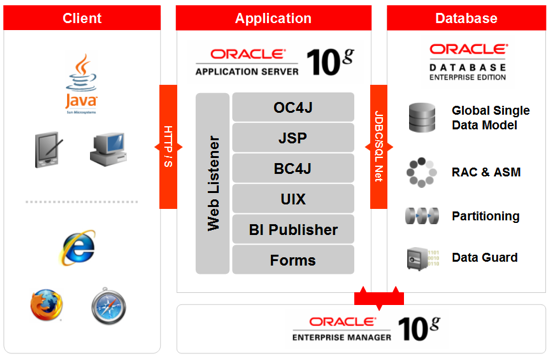[Jul 6, 2009 Update: Database version for 12.0.4 Rapid install was 10.2.0.3, not 10.2.0.4. Table corrected now.
A reader recently asked where she could find a summary of the E-Business Suite Release 12 technology stack components for different R12 releases. As it turns out, there’s a long answer to this deceptively-simple question. This level of
information is spread in a variety of release-specific Notes, making it tricky to compare which components were delivered as part of each Apps 12 Rapid Install.
Here’s a high-level architectural diagram showing an overview of the major techstack components in R12:

It’s possible to add on additional database options not shown above, including 11g Advanced Compression, 11g Advanced Security, and others.
Here’s a summary of the versions for the important major techstack components that were included in the Rapid Install footprints for Oracle E-Business Suite Release 12:
| EBS Release 12 Rapid Install Version | |||
|---|---|---|---|
| 12.0.0 | 12.0.4 | 12.1.1 | |
| Database | 10.2.0.2 | 10.2.0.3 | 11.1.0.7 |
| OracleAS 10.1.2 Forms & Reports | 10.1.2.0.2 | 10.1.2.2 | 10.1.2.3 |
| OracleAS 10.1.3 OC4J | 10.1.3.0.0 | 10.1.3.0.0 | 10.1.3.4 |
| App Tier Java (JDK) | 1.5.0_10 | 1.5.0_13 | 1.6.0_10 |
| Desktop Client Java (JRE) | 1.5.0_10-erdist | 1.5.0_13 | 1.6.0_u10 |
The Case Against Finer-Grained Listings for Internal Components
The table above shows only the major internal components that Apps DBAs can upgrade themselves. Individual upgrades for finer-grained components aren’t required or recommended unless you’re experiencing a particularly severe bug. There are
approximately 120 technology stack components in the E-Business Suite. The fine-grained listings of these components are important to us in EBS Development, since we build the E-Business Suite on them, but they’re mostly irrelevant to EBS sysadmins whose
goal is maintaining their systems.
For example, we track the versioning of individual application tier components like OJSP, Servlet, and SOAP separately from the overall Oracle Containers for Java (OC4J) component. That doesn’t affect your configuration management and operational
plans, though. An Apps sysadmin would simply install the latest certified Oracle Application Server 10g 10.1.3 update to get all of the latest 10.1.3 components bundled with that release.
Integrating EBS with External Oracle Products
Naturally, it’s possible to integrate your EBS environment with a variety of other Oracle products. These products can be running on external — i.e. physically standalone — servers or in a separate ORACLE_HOME on the same server where the E-Business
Suite instance is installed.
Commonly used external integrations are Single Sign-On and Oracle Internet Directory, used respectively for integrating with existing corporate authentication systems like Windows Kerberos, and with existing LDAP directories like Microsoft Active
Directory. External certified product integrations for the E-Business Suite are summarized here.
Updating Individual EBS Components After a Rapid Install
Using Rapid Install to create your initial E-Business Suite environment is convenient, but new Apps DBAs should understand that this is a starting point. Your journey doesn’t end here — it begins. If you haven’t already seen these two articles,
they’re mandatory reading for Apps DBAs:
- On Apps Tier Patching and Support: A Primer for E-Business Suite Users
- On Database Patching and Support: A Primer for E-Business Suite Users
We regularly release new certifications for EBS technology stack components. Our certification announcements archive tells the tale. Including incremental announcements
for specific operating system platforms and special architectures, we released almost 40 new certifications for Apps 12 in 2008. We’re already up to 20 new certifications for 2009.
You can keep up with the news about the latest certifications by monitoring or subscribing to this blog. If you’re looking for a one-page summary of all of the latest technology stack components certified with the E-Business Suite, bookmark this Certification
Summary.
Related Articles
